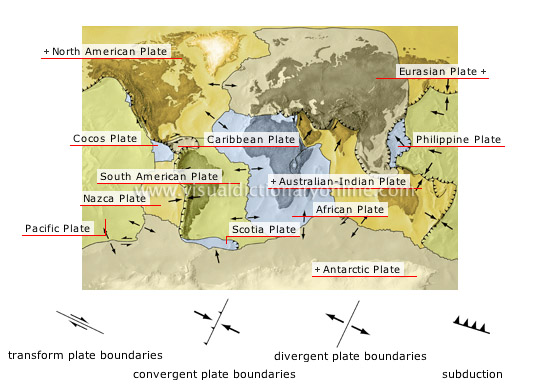tectonic plates
Immense portions of the lithosphere that slide over the asthenosphere; this shifting movement shapes the Earth’s topography.
Cocos Plate 
Plate along the coast of Mexico and Central America; it is sinking beneath the North American Plate and the Caribbean Plate.
North American Plate 
Together with the Pacific Plate, this plate creates the San Andreas Fault (750 mi), which extends from the Gulf of California to San Francisco.
Antarctic Plate 
The largest plate; it is stationary.
Australian-Indian Plate 
Plate that is moving north 3 in per year; it forms the Red Sea by means of divergence from the African Plate.
Philippine Plate 
Plate that forms the Philippines archipelago by means of subduction with the Eurasian Plate.
Eurasian Plate 
Plate converging with the Australian-Indian Plate; it created the Himalayas.
African Plate 
Plate that, diverging from the South American Plate, forms an underwater mountain chain.
South American Plate 
Plate that forms the Andes cordillera by means of subduction with the Nazca Plate.
Scotia Plate 
Small plate under which the Antarctic Plate and part of the South American Plate are sliding.
Nazca Plate 
One of the most rapidly shifting plates, moving 3 in per year.
Caribbean Plate 
Plate subducting under the American plates; the Caribbean Plate created the islands of the Lesser Antilles.
Pacific Plate 
The only entirely oceanic plate, it is also among the most rapidly shifting plates (4 in per year).
convergent plate boundaries 
Plates that collide, triggering either subduction or folding, which results in the creation of mountains.
divergent plate boundaries 
Plates that are moving apart, causing magma to appear, which solidifies to generate a new crust.
subduction 
Phenomenon by which an oceanic plate slides under a continental plate or under another oceanic plate, resulting in a trench.















